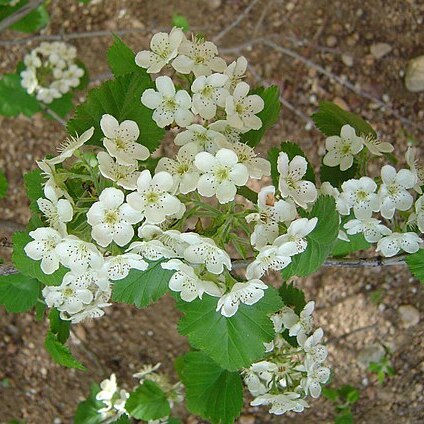Shrubs or trees, 40–100 dm. Stems: ?trunk bark fibrous, checked into longitudinal plates, ± exfoliating or rough-corrugated; compound thorns on trunks frequent in some populations?; twigs: new growth tomentose young, glabrescent, 1-year old tan, older pale gray; thorns on twigs absent or frequent, rarely plentiful, ± straight or ± recurved, 2-years old blackish brown, graying with age, usually ± stout, 3–6 cm. Leaves: petiole length 40–50% blade, tomentose young, tomentose to glabrate mature, usually eglandular; blade ± elliptic to ± ovate or suborbiculate, 4–8(–12) cm, thin to chartaceous, base truncate to cuneate, lobes 0 or 2–6 per side, sinuses shallow to deep, lobe apex acute to obtuse, margins strongly serrate, ?teeth eglandular?, veins 4–7(–9) per side, apex acute to obtuse, abaxial surface pubescent young, densely so on veins, adaxial densely scabrous-pubescent young, densely scabrous-pubescent or glabrous mature. Inflorescences 5–15-flowered; branches tomentose; bracteoles caducous, ?greenish?, linear-lanceolate or narrowly oblong, thin, larger ones subherbaceous, narrowly oblong, membranous to subherbaceous, margins short-stipitate or sessile-glandular, ?multi-veined, abaxially pubescent?. Flowers 20–25 mm diam.; hypanthium densely tomentose; sepals narrowly triangular, 6 mm, margins glandular-serrate to glandular-laciniate, abaxially pubescent; ?petals white, sometimes pink at late anthesis?; stamens (10 or)20, anthers ivory-cream; styles (3–)5. ?Infructescences: fruiting pedicels pubescent?. Pomes bright red, sometimes orange-red or deep red, rarely yellow, suborbicular, ?often tapered at base?, 8–14 mm diam., ± tomentose; sepals obsolescent or erect-patent; pyrenes (3–)5.
More
Tree to 12 m, with a broad, rounded top of widely spreading branches, or sometimes an arborescent shrub, sparingly thorny or nearly thornless; young twigs villous; lvs densely short-hairy above and ± tomentose beneath, becoming glabrous above and more thinly hairy beneath at maturity, highly variable in shape, 3–10 × 2.5–8 cm, usually lobed, rather deeply so on the vegetative shoots; fls 1.6–2.3 cm wide, in tomentose compound cymes; filaments much shorter than the pet; sep coarsely glandular-serrate, tomentose on both sides; fr red, often with pale dots, hairy at least near the ends, 0.9–1.6 cm thick, becoming mellow; nutlets 3–5. Commonest in limestone-regions; N. Engl. and se. Can. to Ala., w. to Minn., Kans., and Okla. (C. arnoldiana; C. canadensis; C. submollis)
A small deciduous tree. It grows up to 10-12 m high. The bark is red-brown. It becomes grey-brown and cracks into scaly plates. The leaves are 4-8 cm long. They are widest below the middle. Leaves are coarsely double toothed. The leaves are dark green and hairy. The thorns are 2-6 cm long. They are straight and slender. The flowers are 2.5 cm across and white with yellow anthers. They occur in broad heads on downy stalks. The fruits are round and 10-12 mm across. They are red.


